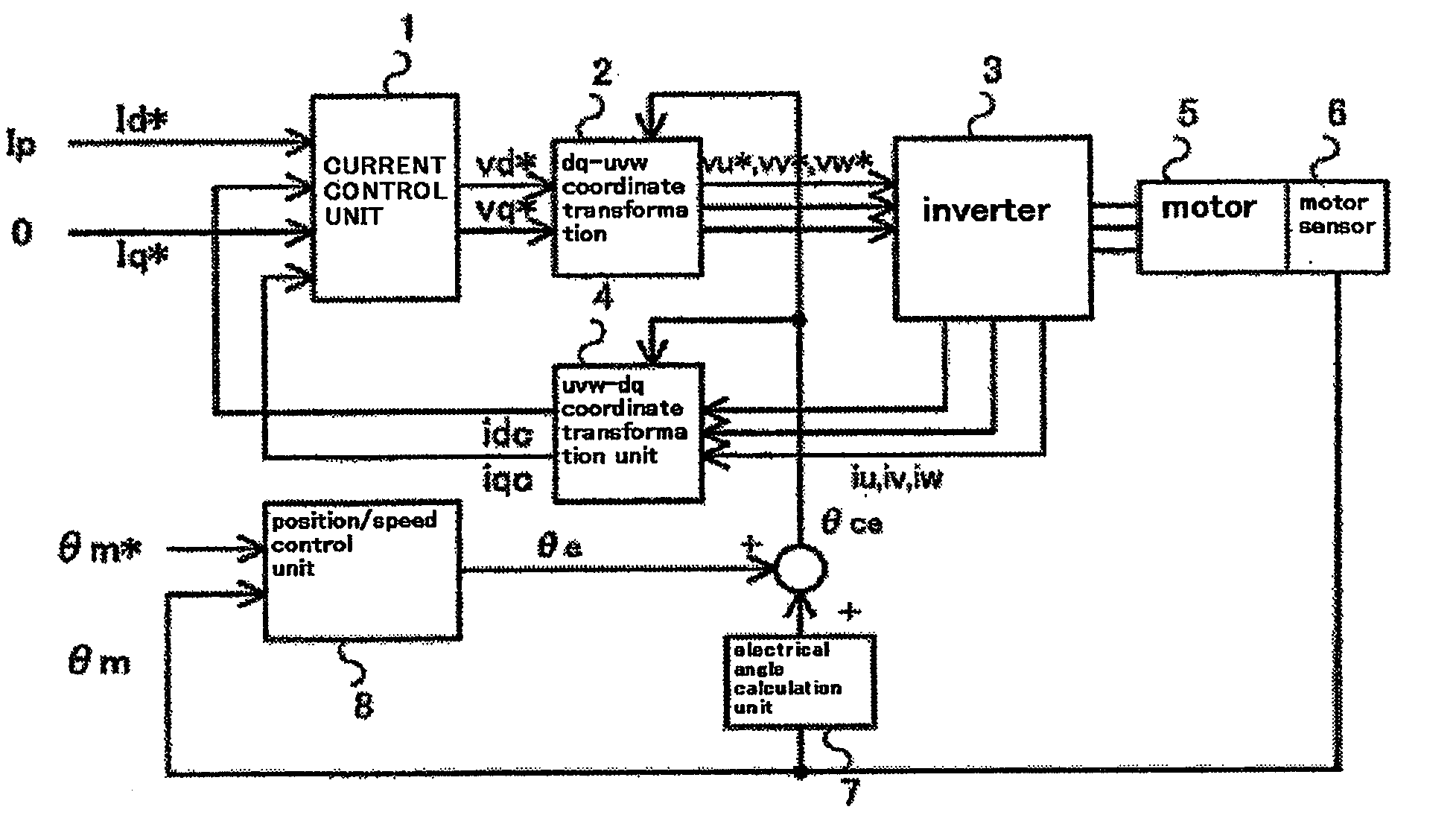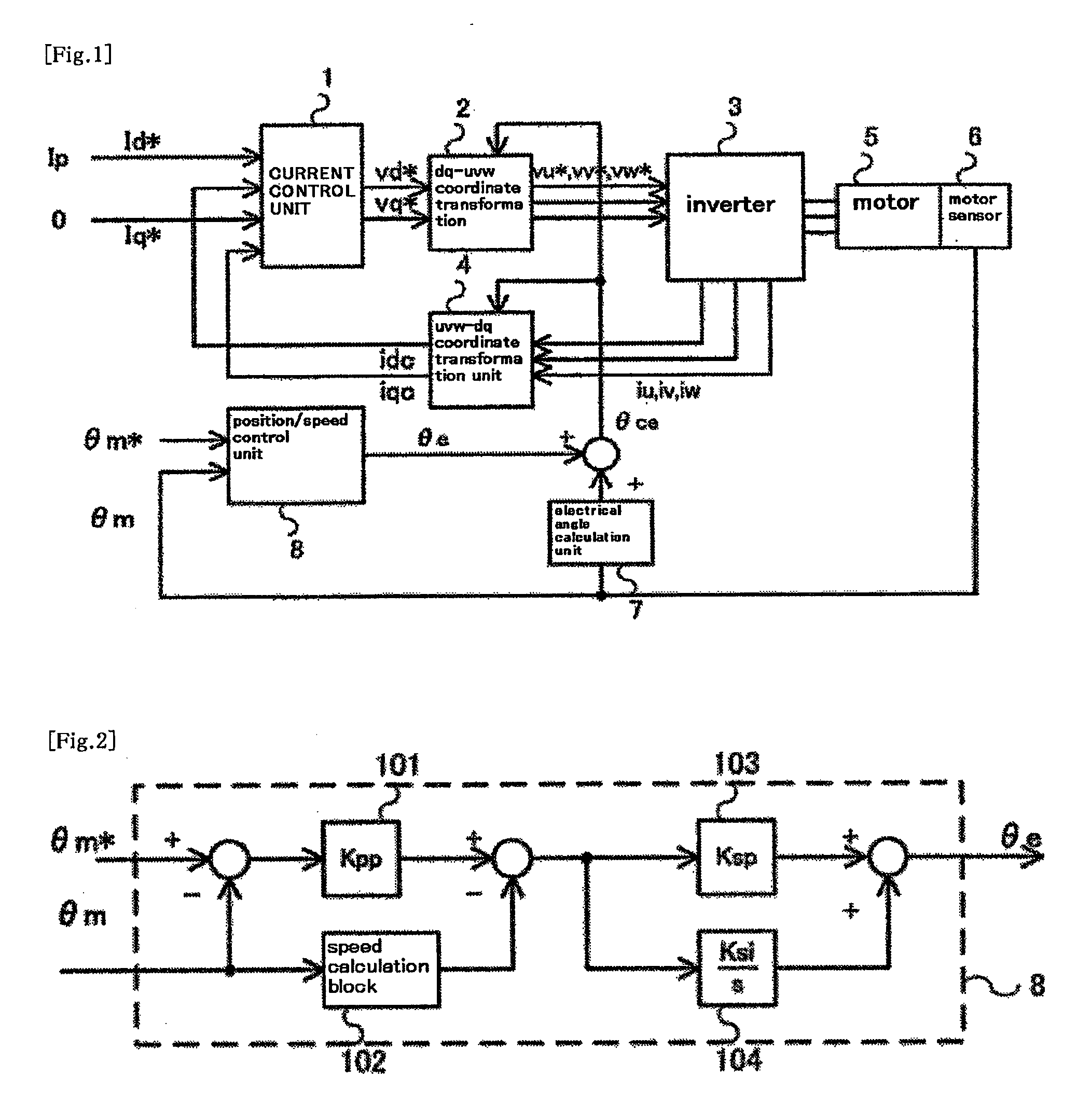Magnetic pole position estimation method for ac synchronous motor
- Summary
- Abstract
- Description
- Claims
- Application Information
AI Technical Summary
Benefits of technology
Problems solved by technology
Method used
Image
Examples
embodiment 1
[0042]A configuration of a magnetic pole position estimation device for an AC synchronous motor according to the present embodiment will be explained. In FIG. 1, a configurational diagram of control blocks to control a magnetic pole position according to the present embodiment is illustrated. Hereinafter, such words as “a relative position of a motor mover”, “relative movement of a motor mover” and “a relative speed of a motor mover” are abbreviated to “a motor position”, “motor movement”, and “a motor speed”, respectively. In addition, “a magnetic pole position” and “a motor magnetic pole position” mean that when a magnetic pole of a motor is configured on a motor mover it is a relative position of the magnetic pole with respect to a reference, and that when one or a plurality of pairs of magnetic poles is configured on a motor stator it is a relative position (equivalent to an electric angle) of the motor mover with respect to a pair of magnetic poles.
[0043]A current control unit ...
embodiment 2
[0074]FIG. 5 illustrates a configurational diagram of control blocks to estimate a magnetic pole position according to the present embodiment. In FIG. 5, the components identical with those in FIG. 1 are referred to as the same numerals in order to omit those explanations.
[0075]In Embodiment 1, the adopted method for generating disturbance torque—error torque—is that a fixed current signal for estimation is applied as a d-axis current in order to shift the pole-error estimation value from that corresponding to the true magnetic pole position; however, in the present embodiment, an adopted method is to apply a signal for estimation whose phase is shifted from the d-axis in a state with no pole error (in a state in which a true magnetic pole position coincides with a target magnetic pole position). More specifically, as shown in FIG. 5, an applied-signal coordinate transformation unit 9 generates dq-axis current command values. In addition, when an application phase θp used in the app...
embodiment 3
[0078]FIG. 6 illustrates a configurational diagram of control blocks to estimate a magnetic pole position according to the present embodiment. In FIG. 6, the components identical with those in FIG. 1 are referred to as the same numerals to omit those explanations.
[0079]A configuration employed in Embodiment 3 differs from that of Embodiment 1 as follows: in order to generate a magnetic pole error, a method in which the pole-error estimation value is changed from that corresponding to a true magnetic pole position is not adopted, but a method in which the estimation-use signal whose phase is shifted from the d-axis with no magnetic pole error is applied, is adopted—an applied-signal coordinate transformation unit 9 generates a command value for dq-axis currents; and an output from a position / speed control unit 8 is not added to a motor electric angle, but is used as a coordinate transformation position for an applied-signal coordinate transformation unit 9. In comparison with the con...
PUM
 Login to View More
Login to View More Abstract
Description
Claims
Application Information
 Login to View More
Login to View More - Generate Ideas
- Intellectual Property
- Life Sciences
- Materials
- Tech Scout
- Unparalleled Data Quality
- Higher Quality Content
- 60% Fewer Hallucinations
Browse by: Latest US Patents, China's latest patents, Technical Efficacy Thesaurus, Application Domain, Technology Topic, Popular Technical Reports.
© 2025 PatSnap. All rights reserved.Legal|Privacy policy|Modern Slavery Act Transparency Statement|Sitemap|About US| Contact US: help@patsnap.com



